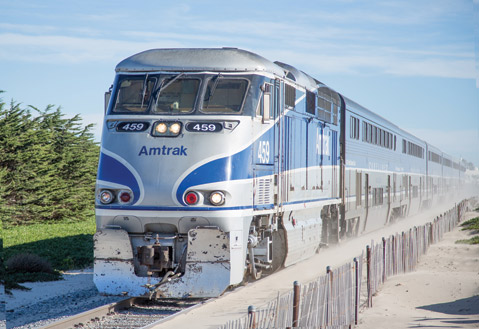Commuter Train Service Expected by Spring 2016
Changes to Pacific Surfliner Schedule to Meet Rush Hour Needs

Come spring 2016, a revised Pacific Surfliner schedule to get commuters to and from Santa Barbara during peak commute hours will likely begin for trains between Moorpark and Goleta, said State Sen. Hannah-Beth Jackson today. “[I]t makes so much sense,” the senator stated in the announcement. “It will alleviate gridlock, get people out of their cars, reduce greenhouse gases, and get people where they want to go faster. It will also be a significant way to reduce gridlock once they begin construction to widen Highway 101.”
A start time of 6 a.m., arriving in Goleta by just before 8 a.m., is part of the game plan being worked out between Union Pacific, Metrolink, and Amtrak, as well as train storage improvements and funding. Stops are expected to be Moorpark, Camarillo, Oxnard, Ventura, Carpinteria, and Santa Barbara. The evening return times are in the works, and the trains should have WiFi and a dining car, and use newer, energy-conserving engines and cars.
“Getting a rail line in place for commuters along the Highway 101 corridor in Ventura and Santa Barbara counties has been a long-standing priority of mine,” Jackson said. She chairs the Senate Select Committee on Passenger Rail and been working with the Governor’s Office and the state Transportation Agency for many months to align train schedules with commuter needs. “I am very hopeful we will see a commuter train in our area beginning next spring.”
An earlier Santa Barbara County Association of Governments attempt to improve commuter rail service — 2008’s Measure A allocates $25 million for such improvements — bogged down because the 5 a.m. start time in Los Angeles interfered with Metrolink service through the San Fernando Valley. Problems also arose with sidings required by Union Pacific for dedicated commuter service between Ventura and Goleta. Jackson broke the logjam by driving home the suggestion that modifying the Pacific Surfliner schedule could avoid both conflicts.
Funding for the improvements exists in last year’s state budget, which included $25 million in cap-and-trade income for state transit and intercity rail projects, with Jackson’s support. She also helped achieve continuing revenue for such projects of a 10 percent share of total cap-and-trade revenue for each succeeding year.
The cap-and-trade program, formed to reduce the state’s greenhouse gas (GHG) emissions, made $532 million in the quarterly auction of credits in 2012-2013. That revenue — expected to be in the billions by 2020 — derives from the buying and selling of industry credits established by the state Air Resources Board and covering about 85 percent of industries producing GHGs. Some credits go to companies for free, some are placed in reserve, and some are sold, but the ceiling descends over time to ultimately reduce GHGs produced in California. In the program, companies producing fewer GHGs than allowed by the Air Resources Board may sell their credits, and those producing more may buy them at auction. On the receiving end, cap-and-trade funds transportation, energy, community development, lands, and waste treatment projects that promote lessening greenhouse gases.
Sen. Jackson’s larger goal is to have two trains run during rush hour between Ventura County through to San Luis Obispo County, though the issue remains of Union Pacific sidings that would need to be constructed. “This first train is an important first step, but I plan to keep working hard on this,” Jackson asserted. “Getting viable commuter rail in our area has enormous, positive implications for our quality of life and the economic future of our region.”



